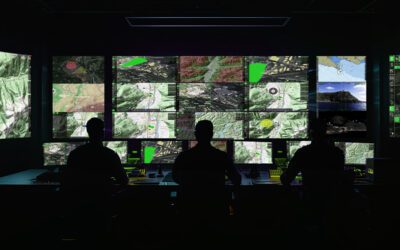Interoperability is a phrase frequently heard in the security sector, encompassing law enforcement and the military. Essentially, it refers to the ability of different elements within a system to interact and exchange information with one another. The principles of security interoperability date back to the fundamentals of the most basic tenets of military strategy – that good intelligence and accurate information are key to a successful engagement.
In the modern arena, interoperability in law enforcement means much more than simply strategising; it refers to the ability of different hardware and software to integrate, allowing diverse systems, units, and even nations to work together. From the Five Eyes to NATO operations, Interpol and national and international law enforcement agencies, data sharing in the security sector is a strategic essential.
Still, barriers do exist that hinder the free flow of information. In this article, we’ll examine interoperability of data and systems in the policing, defence and security sectors. We’ll look at the challenges facing the industry and why it’s so important to have good interoperability in policing and other security services. We’ll also examine how technology such as FlySight’s groundbreaking OPENSIGHT Mission Console is aiding modern law enforcement in providing seamless interoperability both on the ground and in the air.
The core elements of interoperability
Interoperability in the security sector relies on a combination of different elements. At the centre is the issue of technical compatibility of hardware, integrated software, and communication systems between agencies. If these measures are in place, data can flow freely and securely, ensuring that outside operatives cannot access potentially sensitive information.
Procedural considerations must also be taken into account to ensure that tactics, operational procedures, and even doctrines are aligned, particularly in the event of joint missions between agencies or different countries.
Throughout all of this, the human element has to be taken into account. Not only does the information need to be shared when groups collaborate in an operation, but the technology used must be easily accessible and usable by everyone, regardless of language or cultural barriers. Without these tenets in place, interoperability in law enforcement or indeed in any other sector is almost impossible.
The challenges of interoperability in the security sector
In addition to ensuring the main principles of interoperability are in place, there are other challenges to overcome. For example, the issue of fragmented data and communication systems that fail to communicate effectively with one another means that any international or cross-departmental interoperability falls at the first hurdle. Without that communication system in place, the entire operation can be compromised.
Other issues include the problem of modern software or hardware being incompatible with legacy equipment or outdated hardware. Any system that connects equipment needs to take this issue seriously into account when organising security interoperability, especially for international operations.
A lack of data standardisation also needs to be addressed. If one part of the operation understands the data and the other doesn’t, communications can instantly start to break down, and vital information can be ‘lost in translation’.
All of this can lead to reduced response times and increased risk of mission failure due to the interoperability issues.
The benefits of having good interoperability between systems in the security sector are obvious. Get all the different parts of a system talking to one another properly, and you benefit from faster coordination between systems and teams, improved situational awareness, decision superiority, and an inherent ability to use advanced technologies. It doesn’t necessarily mean that everyone has to use the same hardware – communication consoles with mission intuitive software can easily be grandfathered over to existing hardware.
Bear in mind, too, that particularly in aerial platforms such as helicopters, there are very few differences in the existing hardware between models. All that then remains is to ensure that communication channels are kept open between the aerial unit and the command centre. In today’s technologically advanced world, where Cloud data storage and satellite-based Wi-Fi are almost universally used, data sharing in the security sector is now easier than ever.
Using interoperability in the policing, defence and security sectors
Any security operation, regardless of its size, adheres to the principles of interoperability. However, the larger the event, the more critical the connection between aerial and ground units is, as well as the unhindered flow of communications and data. With interoperable systems in place, technology takes centre stage in enabling human teams to communicate quickly and effectively.
Utilising data fusion to provide a multi-layered ‘picture’ of the situation, as well as sensor integration to capture that information, overcomes the increased challenge of managing a large-scale operation. Airborne units equipped with multi-sensory cameras, as well as target recognition software, can complement passive data collected from body cameras, CCTV, and other sources.
What data fusion can do as part of security interoperability is to bring all this information together, potentially in real-time, and allow for better decision-making based on more detailed and accurate data. It enables helicopters and ground-based systems to communicate with each other for quick and effective target identification and improved risk management, even when the operation crosses borders.
The strategic advantages of security interoperability
Cross-agency security interoperability offers both strategic advantages and operational benefits. Interoperable systems enable faster mobilisation and rapid deployment of ground units, as well as improved coordination during local, national, and international crises, including search and rescue operations in the aftermath of a natural disaster or border control between nations.
It ensures that resources are shared, optimising the infrastructure and providing a broader and more efficient response while minimising duplicated data. That in itself makes it more cost-effective for everyone involved.
The use of high-tech security interoperability using a single system also reduces cybersecurity risks, ensuring everyone is using the same protocol and is actively sharing intelligence on potential threats to prevent digital defences from being breached. All of this produces an unprecedented level of international collaboration, allowing joint operations, intelligence fusion and coordinated responses to tackle almost any multi-agency scenario.
NATO & Allied Initiatives
NATO and Five Eyes (the intelligence-sharing alliance comprising the USA, Canada, New Zealand, the UK, and Australia) are already at the forefront of security interoperability and data sharing in the intelligence sector. At the top of the list is STANAGs (Standardisation Agreements), which define common standards for equipment, procedures, and terminology within the scope of military and law enforcement operational systems. FlySight’s innovative OPENSIGHT conforms to the STANAG principles, making it compatible with non-related hardware and software systems, particularly those used in aerial platforms such as drones and helicopters.
Other interoperability applications include the Connected Forces Initiative (CFI), which promotes deployable, interoperable, and sustainable forces across NATO.
At a more local or regional level, interoperability encourages local law enforcement and other emergency services to collaborate both on land and at sea. This can include operations such as border management and control, environmental management, including identifying ‘hot spots’ during wildfire seasons, and both land- and sea-based rescue missions.
The most important thing to remember at this point is that framework considerations for interoperability in the security sector are undergoing constant revision. For example, national and international standards (such as NIEM and NATO) must be continuously revised due to the accelerated pace of technological developments.
The revision of legal and privacy policies, both nationally and internationally, will also have an impact, as will the political landscape. Training also needs to be standardised, and agreed-upon protocols must be established between organisations, both locally and potentially globally. To achieve true interoperability, much more than just ‘getting the hardware to talk to the software’ is required.
Ways in which interoperability can be improved
As with any integrated system, there are always opportunities to enhance efficiency and operational effectiveness. Interoperable command systems and unified communication platforms ensure that the flow of information is unhindered. At the same time, the use of cloud-based and mobile-first solutions provides instant access to relevant data from anywhere in the world.
The standardisation of that data using concepts such as big data and data warehousing practices ensures that there is no shortage of usable documentation, whether that’s collected in real-time or is pre-existing data points, including maps, topographical files, or personal information on targets. Using technology solutions such as AI to sift through big data and Enhanced Reality that prioritise security interoperability are also enabling this technology to play a much more relevant role in international law enforcement.
FlySight OPENSIGHT – Security and Interoperability
An advanced mission console that uses customisable Open Code as well as incorporating STANAG 4607 plug-ins, OPENSIGHT Mission Console is a guarantee in aerial security interoperability. Using state-of-the-art image processing and enhancement algorithms, it allows operators to see more clearly, quickly and effectively acquire targets (even in complex urban environments), and utilise Enhanced Reality System to create a better, more detailed overview. That information can then be quickly relayed to command centres and aligned with real-time data from ground-based sources.
Intuitive, easy to integrate into existing systems, and fully capable of communicating effectively with other systems, OPENSIGHT is the future of interoperability in law enforcement.
You can learn more about FlySight’s OPENSIGHT Mission Console by watching our informative videos or downloading the brochure. Or get in touch to learn more about the OPENSIGHT Mission Console solution for the police, military, and security sectors.




